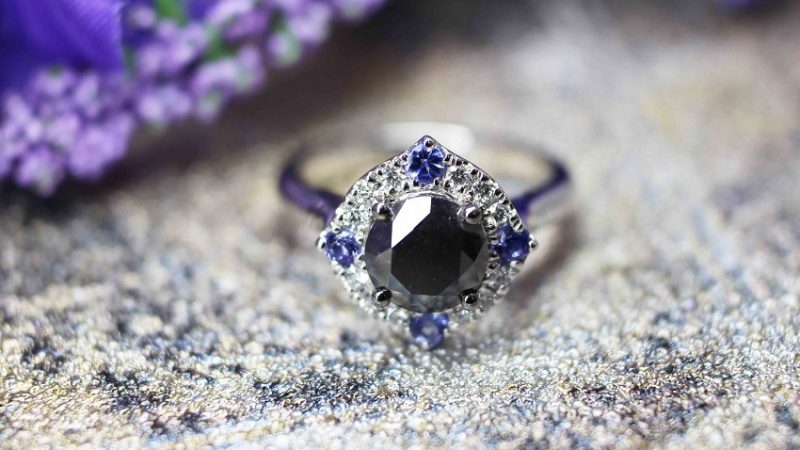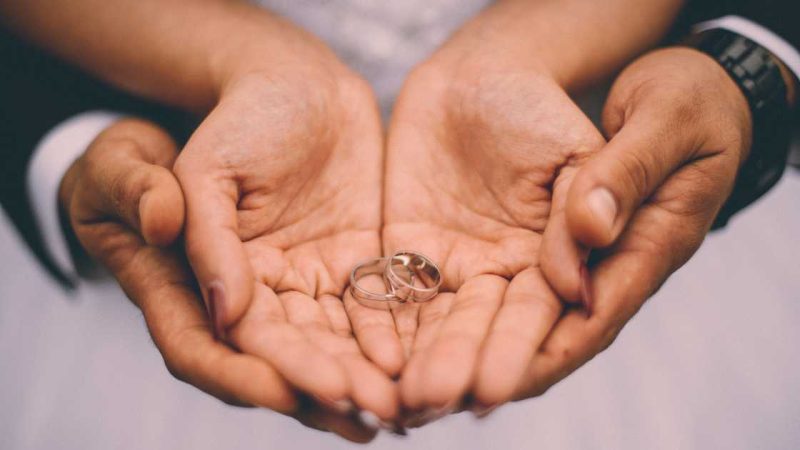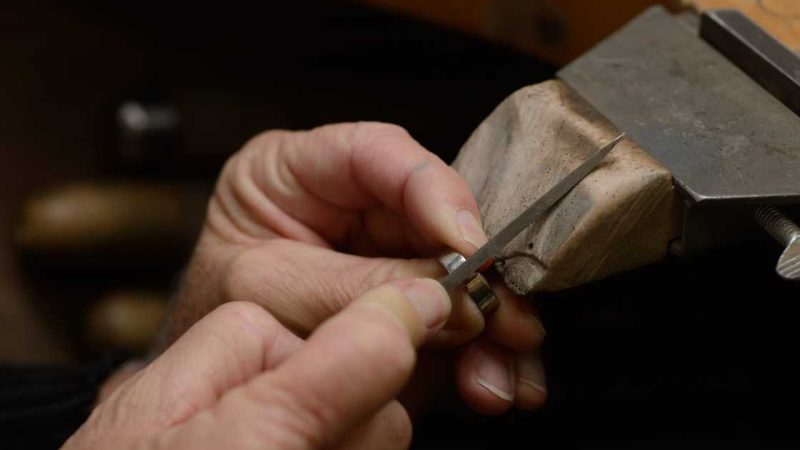Which Wedding Ring Finger Should You Wear Your Wedding Ring on?

For many couples, exchanging wedding rings is an integral part of their marriage ceremony. But which wedding ring finger should you wear your wedding ring on?
The tradition of wearing wedding rings dates back thousands of years and across many cultures. Today, the most common finger to wear a wedding ring on is the fourth finger on the left hand, particularly in Western cultures. This finger is called the ring finger or wedding ring finger. But why is this particular finger designated for wedding rings? Read on to learn more about the history and meaning behind the tradition of wearing wedding rings on the fourth finger of the left hand.
The History Behind The Wedding Ring Finger
The tradition of wearing a wedding ring on the fourth finger of the left hand is thought to originate from a Roman belief that a vein in that finger leads directly to the heart. This vein was called the vena amoris, or vein of love, by the Romans. Although anatomically incorrect, this romantic notion resulted in the practice of wearing wedding bands on this finger as a symbol of love and marriage.
In some Western cultures, the wedding ring is worn on the right hand prior to the wedding, then transferred to the left during the ceremony. In others, the ring is worn only on the left hand. But in either case, the fourth finger is the one associated with marital symbolism.
Here is a quick overview of how the wedding ring finger tradition became popular in various cultures:
- Ancient Egypt: Wedding rings were worn on the fourth finger of the left hand because it was believed the vena amoris ran directly from that finger to the heart.
- Ancient Rome: Adopted the Egyptian tradition due to the belief in the vena amoris. Roman brides and grooms wore rings on the fourth finger.
- Early Christian Europe: Wedding rings symbolized a covenant with God. Rings were worn on the fourth finger following Roman tradition.
- 16th century: Wedding rings gained popularity during the Renaissance and were almost universally worn on the fourth finger.
- Victorian era: The wedding ring finger tradition became codified in Western culture in the 19th century. White wedding dresses also became popularized during this era.
So while the origins of the wedding ring finger tradition stem back thousands of years, it became solidified as a widespread practice in more modern times. Today it is practiced in many countries around the world, regardless of religious or cultural background.
Which Hand Should You Wear Your Wedding Ring On?
While the fourth finger is the most traditional wedding ring finger, you may be wondering – which hand should I wear my wedding ring on? Is the left hand the only option?
Here are some common practices for wearing wedding rings:
- Left hand: In North America, the UK, and many Western countries, the wedding ring is worn on the fourth finger of the left hand. This is considered the traditional and most common placement for wedding rings.
- Right hand: In some European countries, including Germany, Poland, and Ukraine, it is more common to wear the wedding ring on the right hand. Orthodox Christians also often use the right hand for wedding rings.
- Left hand, then right: A Russian wedding ring tradition involves wearing the ring on the right hand prior to marriage, then moving it to the left hand during the wedding ceremony.
- Same positions: Some couples choose to wear a wedding ring on the fourth finger of both the left and right hands, maintaining symmetry.
So while the fourth finger on the left hand is the most popular in many Western cultures, it’s not your only option. The most important thing is that the placement of your ring carries significance for you and your spouse. If wearing it on the right-hand holds special meaning for you, then do what feels right for your relationship.
Why Is It Called The Ring Finger?
Referring to the fourth finger as the “ring finger” dates back to the belief in ancient Rome and Egypt that a vein traveled directly from that finger to the heart. But it wasn’t until the late 19th century that the term “ring finger” became popularized worldwide. Some other key events that solidified it as the ring finger include:
- 1549: The first known reference to the “ring finger” is made in a poem by Edmund Spenser. He calls the fourth finger “the ring finger.”
- 1586: A medical text by Belgian anatomy professor Volcher Coiter refers to the fourth finger as the finger medical texts advise married couples to wear rings.
- 19th century: The use of the term “ring finger” becomes widespread as wedding ring wearing gains broader popularity.
- Early 20th century: Jewelry companies begin marketing products emphasizing the “ring finger” for wedding and engagement rings.
So while ancient Romans may have linked the fourth finger to love and marriage, it took centuries for it to become universally known as the “ring finger” in popular culture. But once wedding ring wearing became standard in Western culture in the 1800s, the name stuck.
What Hand Does An Engagement Ring Go On?
Engagement rings also typically go on the fourth finger of the left hand. While a wedding band symbolizes marriage, the engagement ring signifies commitment and the promise of marriage to come.
Some key engagement ring facts:
- Tradition states it goes on the left ring finger.
- Many styles allow it to fit nicely with a future wedding band.
- After marriage, it is worn alongside the wedding ring on the same finger.
- If desired, it can be transferred to the right hand before the ceremony.
- On the right hand, the engagement ring is traditionally worn on the ring finger or middle finger.
So while you don’t have to stick to tradition, the standard practice is to wear an engagement ring on the same fourth finger as the wedding ring. Wearing a ring on this finger helps signal you are engaged but not yet married.
Other Ring Finger Traditions
While wedding and engagement rings are the most obvious rings worn on the fourth finger, some other commemorative rings can hold meaning on this finger as well. Here are a few examples:
- Promise rings: Worn on the ring finger to signify a promise, such as to a romantic partner or family member.
- Purity rings: Denote a pledge of abstinence until marriage. Typically worn by younger individuals.
- Widowhood rings: Commemorate a deceased spouse. It may be worn on the ring finger until remarriage.
- Divorce rings: Symbolize transitioning from marital status back to single.
- Family rings: Worn to honor children or parents, such as a mother’s ring.
While these types of rings are less common today, they demonstrate how the meaning of rings on the fourth finger has expanded beyond just marriage. The ring finger is seen as a place of commitment, whether in romantic love or family bonds.
Is The Ring Finger Different From Other Fingers?
You may notice that your ring finger appears slightly longer than your index or middle fingers. Is this simply an optical illusion? Or is the anatomy of the ring finger truly unique?
It turns out there are some key anatomical differences that set the ring finger apart:
- Longer: The ring finger tends to be longer in proportion to the index and middle fingers. The ring and middle fingers are similar in length.
- Less mobile: It has greater stability and less independent mobility than the more dextrous index and middle fingers.
- Less muscular: Fewer muscles control the movements of the ring finger, making it appear more slender.
- Lower nerves: It has fewer sensory nerve endings compared to other fingers. This means it may have reduced tactile sensitivity.
So while the differences are subtle, the ring finger does have some unique attributes that make it distinct from your pointer, middle, and pinky fingers. The ring finger’s slimmer profile and greater length give it an ideal shape to prominently display a wedding, engagement, or other symbolic ring.
How Tight Should A Wedding Ring Fit?
Having your wedding ring properly sized to fit your finger is key. But how tight should it fit? Here are some general sizing guidelines:
- Snug but not squeezy: It should slide onto your finger and off with slight resistance and no discomfort.
- Allows some movement: You should be able to wiggle it slightly up and down or spin it around your finger.
- Doesn’t cut off circulation: It shouldn’t compress the finger or leave indentations in the skin. Proper circulation is important.
- Won’t fall off: With proper width and shape, it should stay securely on your finger without sliding or spinning off easily.
Getting your ring finger-sized by a jeweler before purchasing a ring is recommended. Resizing later on is possible if the fit needs adjusting after wearing it for a while.
Also keep in mind your ring size may change over time due to weather conditions, finger injury or swelling, aging, and weight changes. So make sure your ring always fits properly for comfort.
Wedding Ring Finger Etiquette
If you choose to exchange wedding rings, there are some traditional etiquette guidelines to keep in mind:
- The wedding band is traditionally worn stacked closest to the palm, with the engagement ring outside. However, personal preference comes first.
- If you wear your wedding band on your right hand, proper etiquette dictates keeping it on the right after marriage.
- During the ceremony, the ring should be placed directly from the groom’s hand onto the bride’s finger, and vice versa.
- In some cultures, the ring is placed on the thumb first, and then transferred to the ring finger.
- It’s considered impolite to remove your wedding band frequently or fiddle with it excessively at formal occasions.
- If your relationship status changes, either from death or divorce, you can switch your ring to the right hand or remove it.
- Widows often move their ring to the right hand until they feel comfortable no longer wearing it.
- Divorcees may keep rings on the right hand to honor past marriages while moving on.
- Never insult or judge others for their personal choices regarding wearing or not wearing wedding rings.
While customs vary, the most important thing is letting your wedding ring signify what you want it to for your relationship. As long as you and your partner agree on the meaning, the opinion of others doesn’t matter.
Conclusion
While traditions have varied over time and across cultures, the most common wedding ring finger in many Western societies has become the fourth finger on the left hand. The tradition of the wedding ring finger likely originated with ancient Roman and Egyptian beliefs about the connection between that finger and the heart.
Today, wearing a wedding band on this finger represents love and an enduring marital commitment. More flexible norms mean you can also choose to wear your ring on the right hand, or on any finger that feels meaningful to you. The most important thing is letting your wedding ring signify your commitment in a way that resonates with your relationship.
FAQs
What finger does your wedding ring go on?
The traditional wedding ring finger is the fourth finger on the left hand. However, some cultures use the right hand instead. Most Western brides wear their wedding band on their left ring finger.
What hand does a woman’s wedding ring go on?
Typically a woman wears her wedding ring on the left hand, on the fourth finger. This is considered the traditional ring finger for females. But it’s not uncommon for women to sometimes wear a ring on the right hand instead.
What if your engagement ring and wedding band don’t fit together?
If the rings don’t fit comfortably side-by-side, you have a few options. You can wear just the wedding band, just the engagement ring, wear one on each hand, or have the rings fused into a single ring. Choose what works best!
When should you start wearing your wedding ring?
It’s typical to move the wedding ring to your left ring finger during the marriage ceremony. But some cultures wear it on the right beforehand. There are no rules – you can begin wearing your band on either hand whenever you want!
What if your rings are too big?
Rings that are ill-fitting can be prone to lose or cause injury. Consider getting rings that are too large and resized to fit your finger properly. Or insert a ring guard to keep them safely in place.








